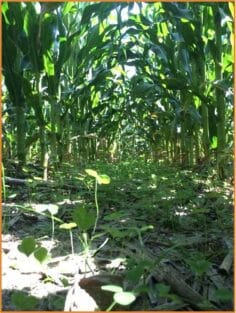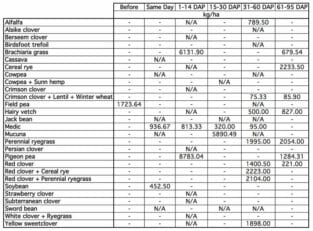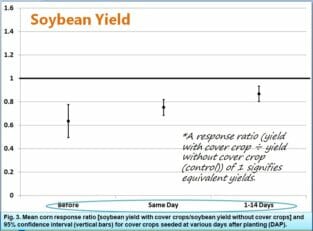Interseeding Cover Crops into Corn and Soybeans: a Meta-Analysis
I presented results from a meta-analysis about cover crop interseeded into corn or soybeans at the American Society of Agronomy annual meetings in Minneapolis, MN. Click here to watch the presentation. Corn and soybean farmers have increased their acres planted to cover crops over the last six years (SARE 2015). Many use cover crops to reduce soil erosion, scavenge nitrogen and dissolved phosphorus, and improve soil health. Many farmers who have used cover crops for two to three years and have experienced less than desirable plant stands are testing seeding alternatives. Farmers have begun experimenting with seeding cover crops within 95 days of main crop planting.
At the beginning of this project the USDA-Risk Management Agency discouraged the seeding of cover crops earlier than physiological maturity of the main crop or later than 95 days after planting (DAP). But now the language has been updated. See the difference between Answer 1 and Answer 2 from the RMA website:
Q: Will over-seeding/interseeding a conservation cover crop into an insured grain crop affect insurability?
A1: No. As long as the cover crop is seeded near physiological maturity of the insured crop and the practice does not interfere with harvest of the insured crop. If there was any damage caused by over-seeding the cover crop (although unlikely), uninsured cause of loss appraisals would be applied to the insured crop.
A2: No. As long as the cover crop is seeded at a time that will not impact the yield or harvest of the insured crop. If there was any damage caused by over-seeding the cover crop, uninsured cause of loss appraisals would be applied to the insured crop.
This meta-analysis reviewed published, peer-reviewed literature to determine the effect on corn or soybean yield and cover crop biomass performance when cover crops were seeded within 95 DAP main crop.
Key search terms like the following were used to find publications for the study:
- “interseeding cover crops”
- “cover crops at V6 seeding”
- “overseeded cover crops”
- “intercropping cover crops“
To be included the publications needed to: i) corn or soybean harvested for grain was the main crop; ii) cover crops were seeded within 95 DAP main crop; iii) cover crop species and planting date, and main crop yield was available.
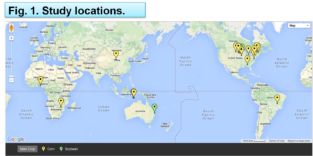
The following cover crops were evaluated.
Lastly yield of corn positively responded to cover crop interseeded 15-30 days after corn planting. Interseeding cover crops at 1-14 days, 31-60 days and 61-95 days after corn planting were mostly neutral on corn yield. 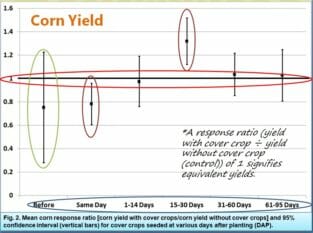
Soybean yield was always negatively affected when cover crops were seeded before, the same day or within 1-14 days of soybean planting.
- Farmers want consistent cover crop stands to reduce soil erosion, improve water quality & increase ROI.
- Soybean yield was negatively impacted with cover crops at all planting dates.
- Corn yield was increased with cover crops at 15-30 DAP and neutral across other DAP; highly variable before planting.
- Mucuna and Pigeon pea yielded the most; soybean, medic or mixture of crimson clover + lentil + winter wheat the least.

